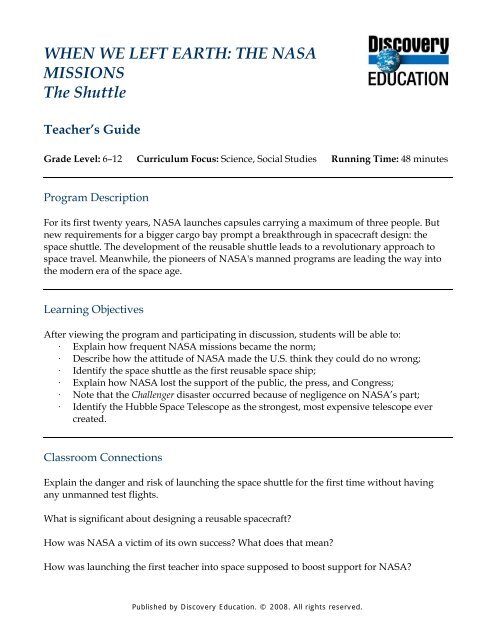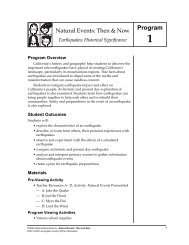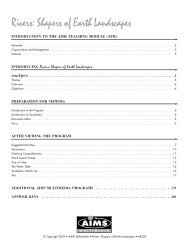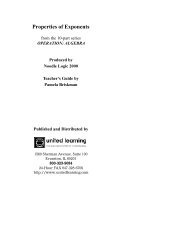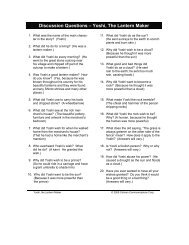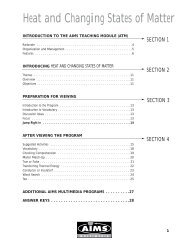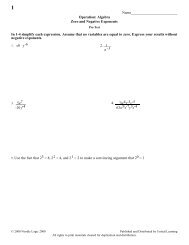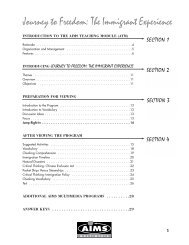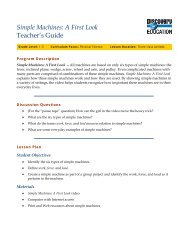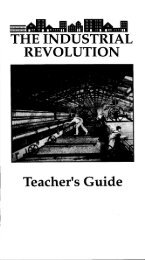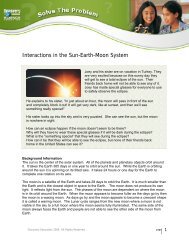WHEN WE LEFT EARTH: THE NASA MISSIONS The Shuttle
WHEN WE LEFT EARTH: THE NASA MISSIONS The Shuttle
WHEN WE LEFT EARTH: THE NASA MISSIONS The Shuttle
You also want an ePaper? Increase the reach of your titles
YUMPU automatically turns print PDFs into web optimized ePapers that Google loves.
<strong>WHEN</strong> <strong>WE</strong> <strong>LEFT</strong> <strong>EARTH</strong>: <strong>THE</strong> <strong>NASA</strong><strong>MISSIONS</strong><strong>The</strong> <strong>Shuttle</strong>Teacher’s GuideGrade Level: 6–12 Curriculum Focus: Science, Social Studies Running Time: 48 minutesProgram DescriptionFor its first twenty years, <strong>NASA</strong> launches capsules carrying a maximum of three people. Butnew requirements for a bigger cargo bay prompt a breakthrough in spacecraft design: thespace shuttle. <strong>The</strong> development of the reusable shuttle leads to a revolutionary approach tospace travel. Meanwhile, the pioneers of <strong>NASA</strong>'s manned programs are leading the way intothe modern era of the space age.Learning ObjectivesAfter viewing the program and participating in discussion, students will be able to:· Explain how frequent <strong>NASA</strong> missions became the norm;· Describe how the attitude of <strong>NASA</strong> made the U.S. think they could do no wrong;· Identify the space shuttle as the first reusable space ship;· Explain how <strong>NASA</strong> lost the support of the public, the press, and Congress;· Note that the Challenger disaster occurred because of negligence on <strong>NASA</strong>’s part;· Identify the Hubble Space Telescope as the strongest, most expensive telescope evercreated.Classroom ConnectionsExplain the danger and risk of launching the space shuttle for the first time without havingany unmanned test flights.What is significant about designing a reusable spacecraft?How was <strong>NASA</strong> a victim of its own success? What does that mean?How was launching the first teacher into space supposed to boost support for <strong>NASA</strong>?Published by Discovery Education. © 2008. All rights reserved.
What were some of the reasons behind the Challenger disaster?What was the purpose of launching the Hubble Space Telescope into space? Was the missionsuccessful?Classroom ActivitiesWork with students to understand morals. What is a moral? What role do morals play in theChallenger disaster? After investigations of what caused the disaster, it was reported that theaccident happened because of “gross negligence” on <strong>NASA</strong>’s part. This means that the disastercould have been prevented, and that <strong>NASA</strong> knew that the cold conditions were too harsh forthe shuttle launch. Is it wrong to do something if the outcome could be bad? Does the fact thata teacher—not a trained astronaut—was killed in the accident change the moral questionssurrounding the tragedy?<strong>The</strong> Hubble Space Telescope was the strongest and most expensive telescope ever created.Students should experiment with the structure of telescopes and discover how they work.Students should focus on the mirror and lens during experiment, concluding the importanceof these parts. Students should then tie their findings into the inaccuracy of the placement ofthe mirror on the Hubble Space Telescope.<strong>The</strong> Hubble Space Telescope was to be launched into space in 1986. It was finally launched in1991. Students should explore reasons why this was postponed. Students should hypothesizethe reactions of the U.S. had the telescope been launched in 1986. Compare these hypotheses tothe reactions of the U.S. when it was discovered that the mirror on the billion dollar telescopewas askew.Target Vocabulary*telescope - a usually tubular optical instrument for viewing distant objects by means of therefraction of light rays through a lens or the reflection of light rays by a concave mirrornegligence - failure to exercise the care that a reasonably prudent person would exercise inlike circumstancesreusable - capable of being used again or repeatedly*By permission. From the Merriam-Webster Online Dictionary ©2008 by Merriam-Webster, Incorporated (www.Merriam-Webster.com)Page 2Published by Discovery Education. © 2008. All rights reserved.
Academic StandardsNational Science Teachers Association<strong>The</strong> National Science Teachers Association (NSTA) has developed national standards toprovide guidelines for teaching science. To view the standards online, go tohttp://www.nsta.org/publications/nses.aspx.This guide addresses the following standards:· Science and Technology· Earth and Space Science· People, Places, and Environments· Science in Personal and Social Perspectives· History and Nature of ScienceNational Council for the Social Studies<strong>The</strong> National Council for the Social Studies (NCSS) has developed national standards toprovide guidelines for teaching social studies. To view the standards online, go tohttp://www.socialstudies.org/standards/strands/.This guide addresses the following standards:· Culture· Time, Continuity, and Change· People, Places, and Environments· Power, Authority, and Governance· Science, Technology, and Society· Global Connections· Individuals, Groups, and InstitutionsPage 3Published by Discovery Education. © 2008. All rights reserved.


